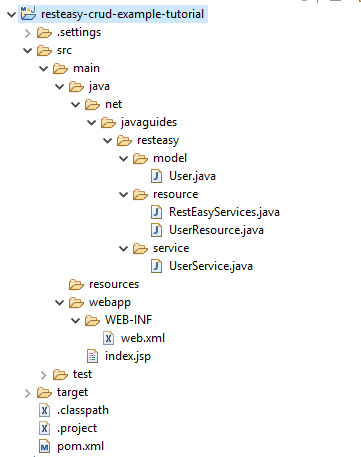In this tutorial, we will learn how to create a JAX-RS Get Rest web services with RESTEasy.
RESTEasy is a Java framework for developing RESTful Web Services. It is a fully certified and portable implementation of the JAX-RS 2.0 specification.
RESTEasy is a Java framework for developing RESTful Web Services. It is a fully certified and portable implementation of the JAX-RS 2.0 specification.
Tools and Technologies used
- JDK 1.8 or later
- Maven 3.5+
- Eclipse IDE
- JAX-RS 2.0 +
- RESTEasy - 3.9.3.Final
- Tomcat 8.5+
Development Steps
- Create a Maven Web project in Eclipse IDE
- Add Maven Dependencies
- Project Structure
- Create a User model class
- Create a UserService class
- Create a UserResource class
- Create an Application Class
- RESTEasy Client for REST API
- Conclusion
1. Create a Maven Web project in Eclipse IDE
Refer below guide to create a web project in eclipse IDE:
https://www.javaguides.net/2018/11/how-to-create-web-project-using-maven-in-eclipse.html
2. Add maven dependencies
Here is the complete Maven pom.xml file. It contains dependencies for RESTEasy, Jackson provider, and RESTEasy client.
<project
xmlns="http://maven.apache.org/POM/4.0.0"
xmlns:xsi="http://www.w3.org/2001/XMLSchema-instance"
xsi:schemaLocation="http://maven.apache.org/POM/4.0.0 http://maven.apache.org/maven-v4_0_0.xsd">
<modelVersion>4.0.0</modelVersion>
<groupId>net.javaguides</groupId>
<artifactId>resteasy-crud-example-tutorial</artifactId>
<packaging>war</packaging>
<version>0.0.1-SNAPSHOT</version>
<name>resteasy-crud-example-tutorial Maven Webapp</name>
<url>http://maven.apache.org</url>
<properties>
<resteasy.version>3.9.3.Final</resteasy.version>
</properties>
<dependencies>
<!-- Set up RESTEasy -->
<dependency>
<groupId>org.jboss.resteasy</groupId>
<artifactId>resteasy-jaxrs</artifactId>
<version>${resteasy.version}</version>
</dependency>
<dependency>
<groupId>org.jboss.resteasy</groupId>
<artifactId>resteasy-servlet-initializer</artifactId>
<version>${resteasy.version}</version>
</dependency>
<dependency>
<groupId>org.jboss.resteasy</groupId>
<artifactId>resteasy-jackson-provider</artifactId>
<version>${resteasy.version}</version>
</dependency>
<!-- RESTEasy Client Dependency -->
<dependency>
<groupId>org.jboss.resteasy</groupId>
<artifactId>resteasy-client</artifactId>
<version>${resteasy.version}</version>
</dependency>
<dependency>
<groupId>junit</groupId>
<artifactId>junit</artifactId>
<version>4.11</version>
<scope>test</scope>
</dependency>
</dependencies>
<build>
<finalName>resteasy-crud-example-tutorial</finalName>
</build>
</project>
3. Project Structure
Refer below screenshot for project structure and packaging structure:
4. Create a User model class
This is a User model class. It contains three attributes: id, name, and email.
package net.javaguides.resteasy.model;
import javax.xml.bind.annotation.XmlRootElement;
@XmlRootElement
public class User {
private Long id;
private String name;
private String email;
public User() {
}
public User(Long id, String name, String email) {
super();
this.id = id;
this.name = name;
this.email = email;
}
public Long getId() {
return id;
}
public void setId(Long id) {
this.id = id;
}
public String getName() {
return name;
}
public void setName(String name) {
this.name = name;
}
public String getEmail() {
return email;
}
public void setEmail(String email) {
this.email = email;
}
@Override
public String toString() {
return "User [id=" + id + ", name=" + name + ", email=" + email + "]";
}
}
5. Create a UserService class
Let's create UserService which provides in-memory storage for user objects. UserService contains CRUD contract methods. We have methods for finding users, saving a user, updating a use, and deleting a user.
package net.javaguides.resteasy.service;
import java.util.ArrayList;
import java.util.List;
import javax.ws.rs.NotFoundException;
import net.javaguides.resteasy.model.User;
public class UserService {
private List < User > users = new ArrayList < User > ();
public List < User > findAll() {
users.add(new User(100 L, "Ramesh", "ramesh@gmail.com"));
users.add(new User(101 L, "Tny", "tony@gmail.com"));
users.add(new User(102 L, "Tom", "tom@gmail.com"));
return users;
}
public User fetchBy(long id) throws NotFoundException {
for (User user: findAll()) {
if (id == user.getId()) {
return user;
} else {
throw new NotFoundException("Resource not found with Id :: " + id);
}
}
return null;
}
public boolean create(User user) {
return users.add(user);
}
public boolean update(User user) {
for (User updateUser: users) {
if (user.getId().equals(updateUser.getId())) {
users.remove(updateUser);
users.add(user);
return true;
}
}
return false;
}
public boolean delete(Long id) throws NotFoundException {
for (User user: users) {
if (user.getId().equals(id)) {
users.remove(user);
return true;
}
}
return false;
}
}
6. Create UserResource class with GET RESTFul web service
package net.javaguides.resteasy.resource;
import java.util.List;
import javax.ws.rs.Consumes;
import javax.ws.rs.DELETE;
import javax.ws.rs.GET;
import javax.ws.rs.POST;
import javax.ws.rs.PUT;
import javax.ws.rs.Path;
import javax.ws.rs.PathParam;
import javax.ws.rs.Produces;
import javax.ws.rs.core.MediaType;
import javax.ws.rs.core.Response;
import net.javaguides.resteasy.model.User;
import net.javaguides.resteasy.service.UserService;
/**
* CRUD Rest APIs for User Resource
* @author Ramesh Fadatare
*
*/
@Path("users")
public class UserResource {
private UserService userService = new UserService();
@GET
@Produces(MediaType.APPLICATION_JSON)
public Response getUsers() {
List < User > users = userService.findAll();
if (!users.isEmpty()) {
return Response.ok(users).build();
} else {
return Response.status(Response.Status.NOT_FOUND).build();
}
}
@Path("/{id}")
@GET
@Produces(MediaType.APPLICATION_JSON)
public Response getUserById(@PathParam("id") Long id) {
User user = userService.fetchBy(id);
if (user.getId() != null) {
return Response.ok(user).build();
} else {
return Response.status(Response.Status.NOT_FOUND).build();
}
}
}
Let's understand the JAX-RS annotations from the above code:
- The @Path annotation specifies the URL to which the resource responds.
- The @GET annotation indicates that the annotated method responds to HTTP GET requests.
- The @Produces annotation is used to specify the MIME media types of representations a resource can produce and send back to the client.
- When creating a new resource, we use @POST annotation.
- The @Consumes annotation is used to specify which MIME media types of representations a resource can accept, or consume, from the client.
7. Create Application Class
Let's create an application configuration class. The Application defines the components of a JAX-RS application and supplies additional meta-data. The javax.ws.rs.core.Application class is a standard JAX-RS class that you may implement to provide information on your deployment:
import java.util.HashSet;
import java.util.Set;
import javax.ws.rs.ApplicationPath;
import javax.ws.rs.core.Application;
@ApplicationPath("/restapi")
public class RestEasyServices extends Application {
private Set < Object > singletons = new HashSet < Object > ();
public RestEasyServices() {
singletons.add(new UserResource());
}
@Override
public Set < Object > getSingletons() {
return singletons;
}
}
Notice that with the @ApplicationPath annotation, we set the path to RESTful web services.
Conclusion
In this tutorial, we have created a GET RESTFul web service with RESTEasy. The application was deployed on Tomcat.
The example used in this article is available as a sample project in GitHub.


Comments
Post a Comment